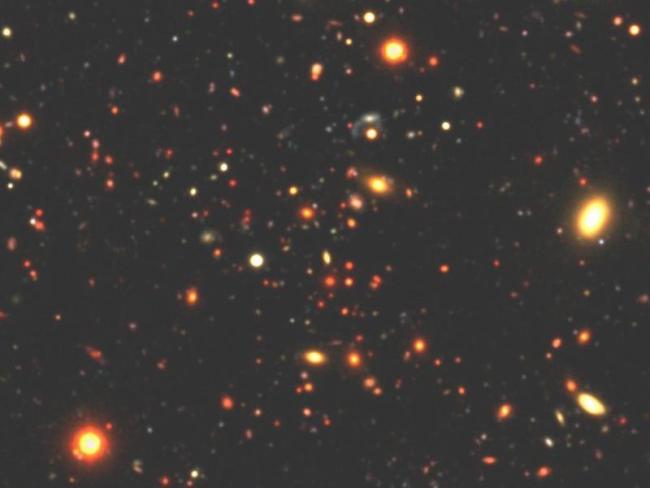
A Hubble Space Telescope image of a small part of the region in the sky that COSMOS measured. Astronomers have studied the active galactic nuclei in this field at X-ray and optical wavelengths.
The most luminous galaxies in our universe are not particularly bright in the visible. Most of their energy is emitted at infrared wavelengths, and astronomers have found examples in which a galaxy emits hundreds or even thousands of times more energy than our Milky Way. The power source of these galaxies is thought to be hyperactive bursts of star formation and/or activity around a massive black hole at a galaxy's nucleus (a so-called active galactic nucleus, or AGN). Astronomers suspect that many normal galaxies, perhaps even including our own, have undergone a phase of luminous activity at some time in their past.
The black holes at the heart of AGN vigorously accrete material in a process that, among other things, typically results in the ejection of jets of particles and the generation of X-rays. Historically, studies of AGN relied on optical surveys; X-rays, which cannot penetrate the atmosphere, require space-based telescopes for their detection. But astronomers have worried that dust around an AGN would obscure the optical light and give false statistical results in optical-only surveys. Indeed, once X-ray telescopes in space began to study AGN, scientists realized that many if not most AGN were missed by optical surveys. Systematic and unbiased studies of the deficit, however, were hard to undertake because they require observing many galaxies out to significant distances where they are faint at all wavelengths.
Four CfA astronomers, Martin Elvis, John Huchra, Francesca Civano, and Heng Hao, together with sixteen colleagues, have just published the results of a lengthy study of 677 X-ray detected AGN in one part of the sky; their work is part of COSMOS, the Cosmic Evolution Survey. For 485 of the objects they obtained spectra and distance estimates using optical telescopes in Chile and Arizona that CfA helps to manage. They find that for not-too-distant galaxies the number of optically obscured AGN is indeed much higher than optically visible ones -- by factors of about 2 to 6, depending on a galaxy's particulars. They also report a strong tendency for the more distant (younger) ones to be more obscured by dust. The team finds no evidence that the nature of central black holes is different across the range of distances. Instead, they argue that star formation is more vigorous in these younger objects, and that the dust associated with star formation is responsible for obscuring the AGN. Their results help to resolve the puzzle about whether, when, and why so many AGN are faint at optical wavelengths. Next, the team plans to use new, more sensitive multiwavelength data to examine the evolution of these AGN.